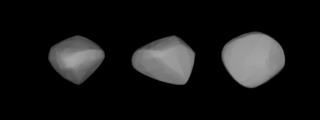
25 Phocaea is a stony asteroid from the inner regions of the asteroid belt, approximately 75 kilometers in diameter. It is the parent body of the Phocaea family. Discovered by Jean Chacornac in 1853, it was named after the ancient Greek city of Phocaea.

Phocaea or Phokaia was an ancient Ionian Greek city on the western coast of Anatolia. Greek colonists from Phocaea founded the colony of Massalia in 600 BC, Emporion in 575 BC and Elea in 540 BC.
The Cyclic Poets is a shorthand term for the early Greek epic poets, who were approximate contemporaries of Homer. No more is known about those poets than about Homer, but modern scholars regard them as having composed orally, as did Homer. In the classical period, surviving early epic poems were ascribed to those authors, just as the Iliad and Odyssey were ascribed to Homer. Together with Homer, whose Iliad covers a mere 50 days of the war, they cover the complete war "cycle", thus the name. Most modern scholars place Homer in the 8th century BC. The other poets listed below seemed to have lived in the 7th to the 5th centuries BC. Excluding Homer's, none of the works of the cyclic poets has survived.

Foça is a municipality and district of İzmir Province, Turkey. Its area is 251 km2, and its population is 34,946 (2022). The town of Foça is situated at about 69 km (43 mi) northwest of İzmir's city center on the Aegean coast. The district has a settlement and former municipality named Yenifoça, also along the shore and at a distance of 20 km (12 mi) from Foça proper. For this reason, Foça itself is locally often called as Eskifoça in daily parlance. The town is built on the site of the ancient Greek city of Phocaea.
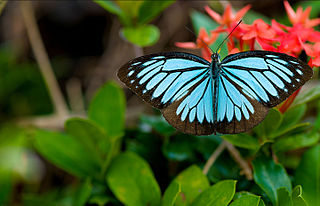
Pareronia valeria, the common wanderer or Malayan wanderer, is a medium-sized butterfly of the family Pieridae, that is, the yellows and whites, and is found in India and Southeast Asia. The butterfly found in India is sometimes considered as a separate species, Pareronia hippia.

Pareronia ceylanica, the dark wanderer, is a medium-sized butterfly of the family Pieridae, that is, the yellows and whites. It is found in Sri Lanka and India.

Pareronia is a genus of butterflies of the subfamily Pierinae within the family Pieridae. The species are found in Southeast Asia and are mimics of the Danainae genus Parantica.

Maona of Chios and Phocaea was a maona formed to exact taxes for the Republic of Genoa from the island of Chios and port of Phocaea. Genoa sold the rights to their taxes to the maona, which raised funds from its investors to buy galleys and eventually re-conquer Chios and Phocaea.

The Lordship of Chios was a short-lived autonomous lordship run by the Genoese Zaccaria family. Its core was the eastern Aegean island of Chios, and in its height it encompassed a number of other islands off the shore of Asia Minor. Although theoretically a vassal of the Byzantine Empire, the Zaccaria ruled the island as a practically independent domain from its capture in 1304 until the Greek-Byzantines recovered it, with the support of the local Greek population, in 1329. The island would return to Genoese control in 1346 under the Maona of Chios and Phocaea.
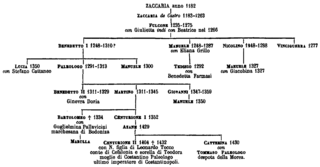
Benedetto I Zaccaria was an Italian admiral of the Republic of Genoa. He was the Lord of Phocaea and first Lord of Chios, and the founder of Zaccaria fortunes in Byzantine and Latin Greece. He was, at different stages in his life, a diplomat, adventurer, mercenary, and statesman.
The Phocaea family is a collisional family of asteroids located between 2.25 and 2.5 AU in the inner region of the asteroid belt. Phocaea asteroids are of stony S-type composition and have orbits with eccentricities greater than 0.1 and inclinations between 18 and 32°. The family has an estimated age of 2.2 billion years and derives its name from its most massive member, 25 Phocaea which is about 75 km in diameter. Several Phocaean asteroids are also Mars-crossers.
Evander, born in Phocis or Phocaea, was the pupil and successor of Lacydes, and was joint leader (scholarch) of the Academy at Athens together with Telecles.
Telecles, of Phocis or Phocaea, was the pupil and successor of Lacydes, and was joint leader (scholarch) of the Academy at Athens together with Evander.

Pareronia tritaea is a butterfly of the family Pieridae. It is found in Indonesia and the Philippines.
Halil Bey (1347–1362) was an Ottoman prince. His father was Orhan, the second bey of the Ottoman beylik. His mother was Theodora Kantakouzene, the daughter of Byzantine emperor John VI Kantakouzenos and Irene Asanina. His kidnapping was an important event in 14th century Ottoman-Byzantine relations. He was killed by his brother Murad I.
İlyas Bey was the second bey (lord) of the Turkish beylik of Saruhan in the 14th century.

Pareronia hippia, the common wanderer or Indian wanderer, is a medium-sized butterfly of the family Pieridae, that is, the yellows and whites. It is found in India. Some authors consider this as a subspecies of Pareronia valeria.
The Lordship of Phocaea was founded after in 1275, when the Genoese nobleman Manuele Zaccaria received the twin towns of Old Phocaea and New Phocaea as a fief from the Byzantine emperor Andronikos II Palaiologos. The Zaccaria family amassed a considerable fortune from their properties there, especially the rich alum mines. The Zaccaria held the lordship until 1340, when it was repossessed by the Byzantines under Andronikos III Palaiologos.
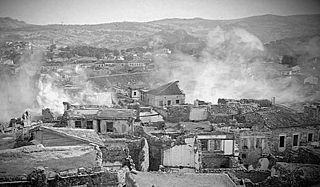
The massacre of Phocaea occurred in June 1914, as part of the ethnic cleansing policies of the Ottoman Empire that included exile, massacre and deportations. It was perpetrated by irregular Turkish bands against the predominantly ethnic Greek town of Phocaea, modern Foça, on the east coast of the Aegean Sea. The massacre was part of a wider anti-Greek campaign of genocide launched by the Young Turk Ottoman authorities, which included boycott, intimidation, forced deportations and mass killings; and was one of the worst attacks during the summer of 1914.
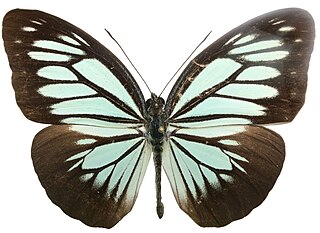
Pareronia boebera is a species of pierine butterfly endemic to the Philippines.












